You’ve likely heard of meditation for adults, and maybe you’ve even learned about the many benefits it offers, but have you ever considered meditation for kids?
While the thought of getting your child to sit calmly for long enough to reap the rewards of meditation might feel overwhelming, it doesn’t have to be.
We at HOMER have compiled our favorite tips and tricks to start building a simple meditation routine with your child. Take a look below to get started today!
What Is Meditation?

At its core, meditation is a practice of mindfulness and self-awareness, and meditation for kids is no different. By practicing meditation regularly, we can teach our minds to observe stressful thoughts without judgment and learn to relax when we need to most.
Particularly in today’s society with the constant barrage of information and technology coming at us all day long, we allow ourselves very little downtime to breathe, relax, and simply be with our thoughts.
How exhausting!
Meditation helps us switch off distractions — whether that’s something stressful externally, like a thunderstorm, or busy thoughts racing through our minds — and stay focused on the present moment.
Who Can Benefit From Meditation?
Anyone can learn to meditate, even kids! Children as young as two years old can benefit from meditation and the peace of mind it brings.
By incorporating meditation for kids into their daily routine, your child will have the opportunity to tap into this valuable skill at a moment’s notice to help them find peace and quiet whenever they need it.
The Benefits Of Meditation For Kids
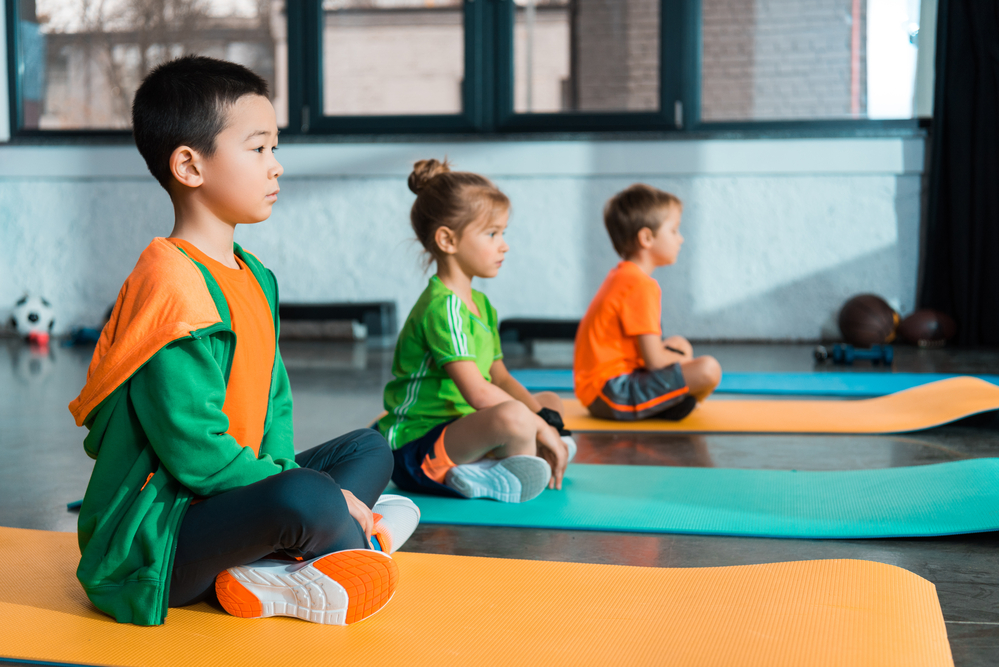
For many of us, meditation is something we started as adults after hearing about or reading up on its benefits. But imagine if we had been introduced to it when we were much younger.
Could we have navigated those emotionally challenging teenage years better? Would we have managed to deal with exam stress more effectively? How about speaking to our parents, siblings, and friends with more kindness?
The answer is a big YES to all of these questions. Multiple studies have shown the great benefits of meditation in kids’ lives.
One study showed the effectiveness of mindfulness meditation in adolescence; another one revealed how meditation helped students perform better academically; and this study focused on the link between emotional intelligence and meditation in teens.
This is just some of the resounding evidence that speaks to one fact: Meditation can be incredibly beneficial in many aspects of children’s lives.
Here are other notable ways meditation can help your child:
- Improved sleep
- Increased focus and prolonged attention span
- Reduced stress and anxiety
- Stronger mental resilience
- Improved emotional regulation
- Increased self-awareness and empathy
In addition to the above benefits, studies have shown that meditation can help children by improving their working memory capacity.
In a nutshell, this is the cognitive ability to selectively maintain and manipulate said information without getting easily distracted over short periods of time. This can result in improved academic performance, including mathematical and literacy skills.
Now, you may be sold on all of these incredible advantages, but you just have one question: Can every child meditate?
As a parent, it can be challenging to imagine your child sitting still and focusing on a guided meditation. You’ve witnessed their limited attention span and know how easily they get frustrated. Surely this is for some supernatural kids and not yours.
You’ll be pleased to know that children can actually be great at meditation! We sometimes forget how willing and receptive kids are to new experiences. Their curious minds tend to embrace new things.
So, while it’s normal to be a little anxious about introducing meditation to your child, the incredible benefits are worth it.
The Basics Of Meditation For Kids
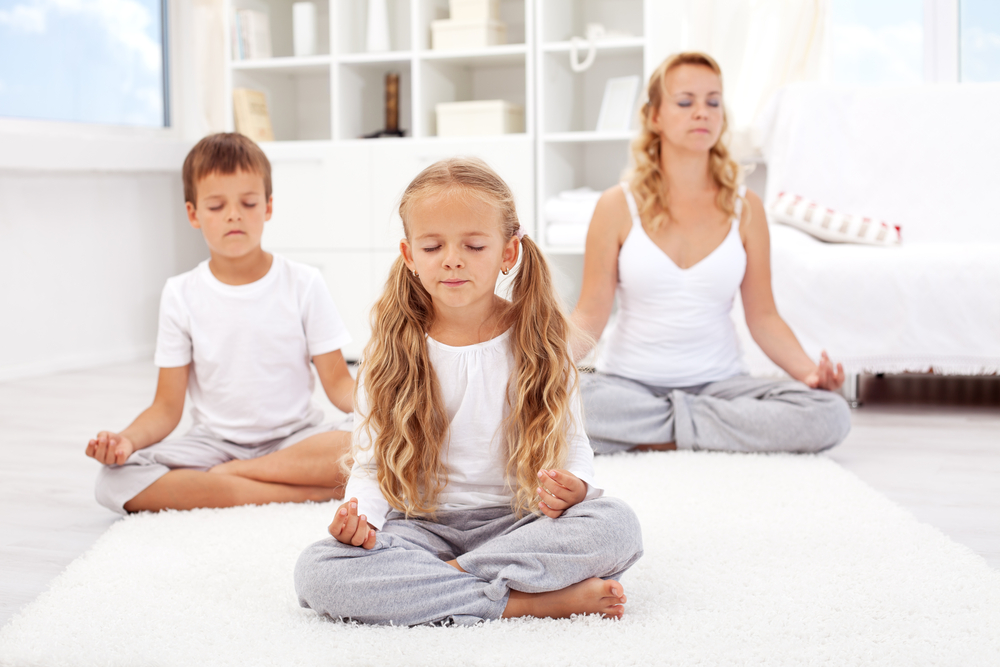
Now that we’ve covered the benefits of meditation for kids, let’s dive into exactly how to get started!
Comfort
You may want to start your meditation session by doing a 30-second dance party, stretching, or jogging on the spot — anything to get those wiggles out and help your child get ready to sit quietly and have some focus time.
Once you’re both ready, it’s time to get comfortable and begin preparing to meditate. Despite what comes to mind when you picture meditation, you don’t always have to sit cross-legged with your hands on your knees!
Meditation practice should begin with your child sitting or lying in a comfortable position — whatever feels best.
If sitting with your legs crossed is most comfortable, start with that position. If your child feels most comfortable lying flat on their back, that’s fine, too!
Focus With Breathing
Focusing on the sensations we feel in our bodies is a great way to begin practicing mindfulness and meditation, particularly for younger children who may have difficulty concentrating for long periods.
Start by focusing on simply breathing in and out. Have your child place one hand on their belly and the other hand on their chest. Have them notice how their chest and belly rise when they inhale and fall during exhale.
You can count out loud while doing this breathing exercise. Try breathing in for the count of four, holding for two counts, and breathing out for the count of six.
Your child may find it relaxing to close their eyes during this exercise, or they may prefer to have their eyes open.
After five total counts of breathing, ask your child how they’re feeling. They might feel happy, calm, relaxed, or they may even feel restless or grumpy.
Identifying these emotions along with their bodily sensations is the first step of mindfulness — all emotions are OK! If your child becomes overwhelmed or too restless to continue, tell them you’ll try again tomorrow.
It’s important to let your child take the lead when you’re starting out with meditation for kids. Pushing them too hard too quickly may make them want to avoid it altogether.
Story

Once you feel that your child has grasped the basics of slow, mindful breathing, you can begin to incorporate storytelling into your meditation practice.
This meditation technique is especially helpful to use as part of your child’s bedtime routine so they can relax before sleep.
After finding a comfortable position, have your child close their eyes and bring all of their attention to their breath. They might even like to have their hand on their belly to feel the rise and fall as they inhale and exhale, just as with our simple breathing exercise.
Begin telling your child a story that will allow them to focus on how their body is feeling, bringing their attention to how comfortable the bed feels on their back or how soft their blanket feels on their skin.
The story can incorporate their favorite toys, people, or places and should be relaxing while allowing them to use their imagination and visualize what you’re describing.
For example, you could say something like, “You’re lying on your bed; what do you feel? Do you feel the smooth sheets? Your soft blanket? Your stuffed elephant is whispering goodnight to you in the sweetest voice. Can you hear her?”
Body Scanning
Body scanning and progressive muscle relaxation are simple techniques that allow you to help your child get in touch with their body.
Start by lying down flat on your back with your eyes closed and having your child do the same right next to you.
Beginning with the top of your head, ask your child to notice if they feel any tightness or squeezing feelings in their scalp. Have them picture any tightness melting away like ice cream until their head is completely relaxed.
Move down, muscle by muscle — the nose, the mouth, the neck, the shoulders — until they’ve relaxed all their muscles down to each of their 10 toes one-by-one.
You may even want to ask your child to squeeze each muscle as you progress through their body. This helps them feel the difference between a tight muscle and a calm, relaxed muscle.
Expert Tips For Child Meditation
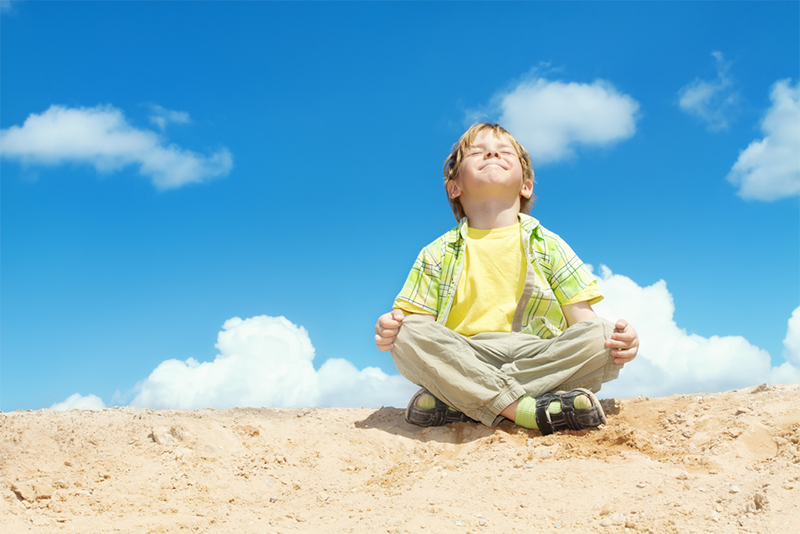
1) Meet Your Child Wherever They Are
When it comes to meditation for kids, you might be tempted to set goals together and work toward meditating for a particular amount of time. This is great! Just remember not to set those goals too high.
When you’re first starting out with meditation, it’s best to start small and work your way up to longer periods of meditation as your child feels more comfortable with sitting still and focusing.
Try just 30 seconds to start, then increase until you and your child are able to practice meditation together for a full minute.
As you and your child gradually begin to look forward to your meditation practice, you can increase up to 10 minutes for each session.
Meeting your child wherever they are in terms of their ability to focus is key to building a meditation practice that you both enjoy. It will also help them create solid mindfulness habits that they can incorporate into their everyday life.
2) Maintain Consistency
As with anything you want to become great at, consistency is key! Try to keep the time of day (morning or evening), the place (a dedicated chair or rug, for example), and even your child’s clothing (anything comfortable) consistent.
This helps your child to associate the time, place, and outfit with relaxation and helps their brain switch into mindfulness mode.
3) Keep Practicing
If at first you don’t succeed, try, try again! Meditation is called a practice for a reason — it takes a lot of repetition to become masterful.
It can be overwhelming (even for adults!) to take time out of your day or evening and simply be still, so don’t be too hard on yourself or your child if it takes a while to warm up to the art of meditation.
Allow time for yourself and your child to get comfortable sitting with your thoughts, your breathing, and your bodies.
Stick with it long enough to see the benefits meditation offers and you’ll find it easier to complete your sessions.
Meditation Techniques By Age
It’s important to consider your child’s age when starting their meditation journey. For example, it’s more realistic to have a 10-year-old sit quietly for 10 minutes as opposed to a 3-year-old.
Here’s a closer look at how you can introduce meditation and mindfulness to your child in a way that’s most relevant to their age.
For Toddlers (1-3 Years Old)
At this early age, meditation is focused on mindful movement. To get started, speak to your child about things that make them feel happy. This can be butterflies, mommy, daddy, ice cream, a superhero, and everything else in-between.
After focusing on the good feelings, it’s time to address the opposite. Ask your child to think of anything that makes them unhappy and where they feel that unhappiness on their bodies.
Then, to help relieve those negative feelings, encourage your child to take slow, deep breaths. This simple method helps train the brain to immediately recognize stress signals and know how to respond so that the body returns to balance.
A child who learns this from an early age may be able to practice self-care even when you’re not around.
For Preschoolers (3-5 Years Old)
For preschoolers, meditation can involve elements of a story. A great starting position is to have them lying down, relaxed.
This is a great age to begin incorporating the story element of meditation that we discussed above. Consider narrating a story to your child that gently encourages them to consider how each of their body parts feels.
For Kindergarteners And Older (5 Years +)
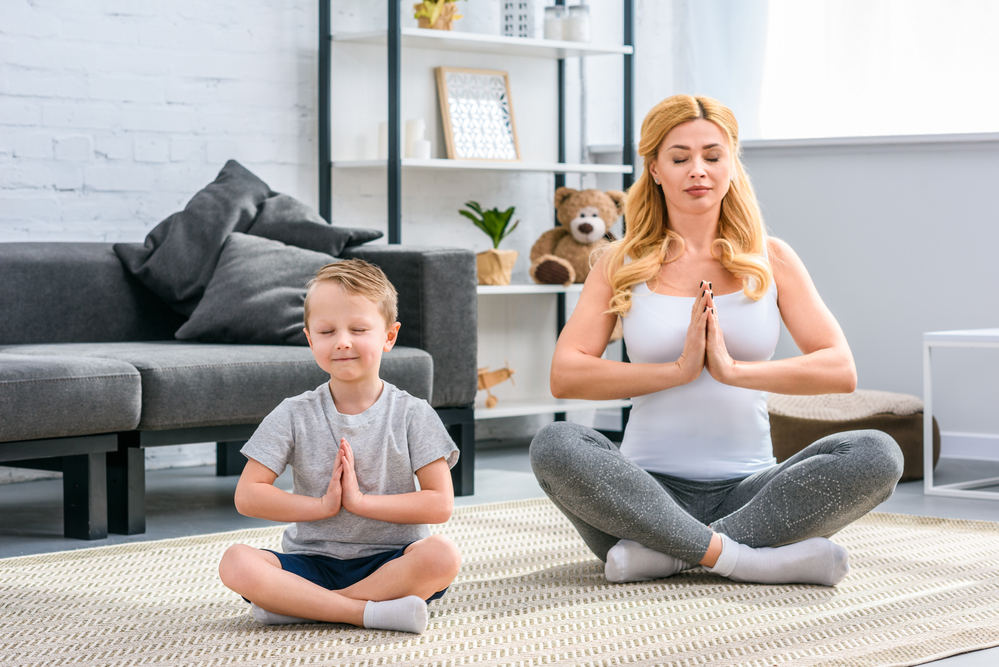
There are multiple ways to make meditation inviting for school-aged children. Music is one of the most effective methods.
Traditional meditation involves Tibetan singing bowls. These bowls work well because they vibrate at frequencies that help restore parts of the body that are out of balance.
While this may sound great, most of us don’t have Tibetan singing bowls lying around the house. So, another option for incorporating music is to play nature sounds for your child. This can also bring them some calm.
FAQs About Meditation
1) How Often Should My Child Meditate?
The best approach for incorporating meditation into your child’s routine is to commit to the practice frequently. Even if it’s just 30 seconds every day to start with, this half-minute will soon turn to five minutes, 10 minutes, and possibly even more the older they get.
While on this journey, meditating every day may not be easy. Some days your child will be more than willing to participate. Other days, not so much.
The key is to remain patient and consistent as you help guide them. Considering all the benefits mentioned above, it will be worth this time and effort.
2) How Soon Will The Benefits Appear?
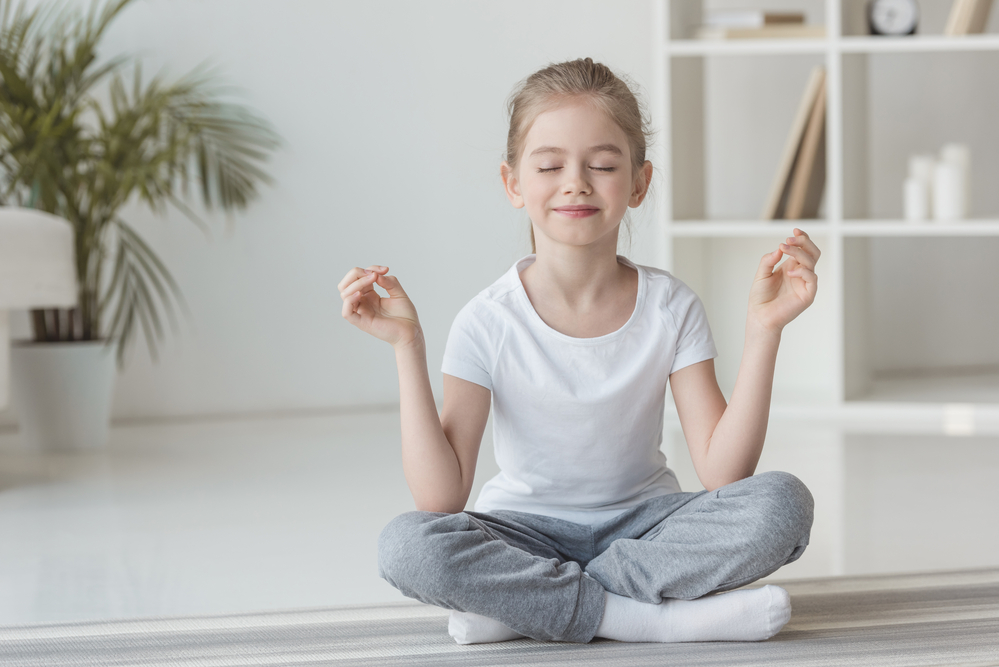
If you’re a goal-oriented person, this question may be the most important to you. When exactly will you start seeing the benefits of meditation in your child’s everyday life?
You want to make sure you’re on the right track. We get it. But one of the best things about meditation is that you can’t actually do it wrong.
The most important thing is to start. As soon as you sit down with your child to meditate, you’re already halfway there.
And when you’re looking for the results, it’s probably not going to look like fireworks or flashing lights above your child’s head. Instead, it may be seen in much subtler ways. For example, your child may start sleeping better after struggling for a while.
Instead of focusing on the results, just trust in the process, and the rest will take care of itself.
3) Are There Books That Can Help Me?
Here at HOMER, we love a good book. So, of course, we went searching for some of the best books on kids’ meditation out there.
The books below cover meditation and mindfulness activities and games that you can use at home.
- Meditation for Kids: 40 Activities to Manage Emotions, Ease Anxiety, and Stay Focused (For 4-8-Year-Olds)
- Bedtime Meditations for Kids: Quick, Calming Exercises to Help Kids Get to Sleep (For 4-8-Year-Olds)
- Breathe Like a Bear: 30 Mindful Moments for Kids to Feel Calm and Focused Anytime, Anywhere (For 4-8-Year-Olds)
- Mindful Games For Kids: 50 Fun Activities to Stay Present, Improve Concentration, and Understand Emotions (For 4-8-Year-Olds)
4) Are Some Meditation Styles Better Than Others?
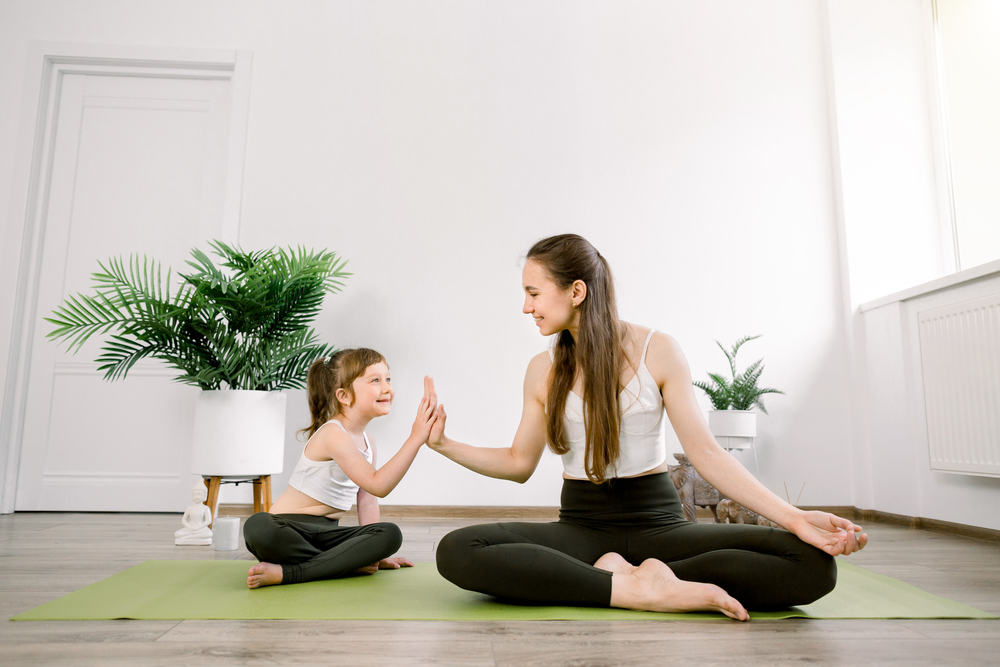
Different types of meditation can be the most beneficial for children. Below are some of the most common.
Mantra Meditation
As the name suggests, this is where a syllable, word, or phrase is repeated during the meditation session. This mantra can be spoken, whispered, chanted, or repeated in the mind. Om is one of the most common mantras people use.
Using a mantra can help your child focus on the word or phrase alone. It encourages them to avoid any distractions, including memories, sensations, and thoughts.
Mindfulness Meditation
Mindfulness has been increasingly popular over the past few years. And with its popularity, unfortunately, there have been many misconceptions about what it means.
Many people view it as a way to clear their minds and reach a calm or relaxed state. While these can be some of the benefits, that isn’t what mindfulness is.
In a nutshell, mindfulness is about being present. It’s about being aware of your thoughts and feelings, what you’re hearing and seeing, and everything else around you. Our minds can often be distracted by both internal and external stimuli. Mindfulness helps you focus on the present.
Some of the most effective mindfulness meditation techniques for children (and adults) are breathing techniques.
By encouraging your child to focus on their breath, they may observe their thoughts, feelings, and the sensations around them. This allows them to be more in tune with their body and mind.
Guided Meditation
This style of meditation involves listening to a practitioner in person or through an audio recording. It can include music, words, or both.
Guided meditations can have specific focuses. For example, some may focus on improving sleep or calming the mind.
After looking at these different meditation styles, you may wonder which is best for your child. While people may prefer one style over another, the reality is that there is no “best” way to practice meditation. There is also no single technique that works for every child.
The best way to approach meditation for kids is to try out the different styles with your child to see which one is the most effective. Once you’ve found a technique that your child responds well to, work on making it a regular practice.
Enhance Your Meditation Journey With HOMER
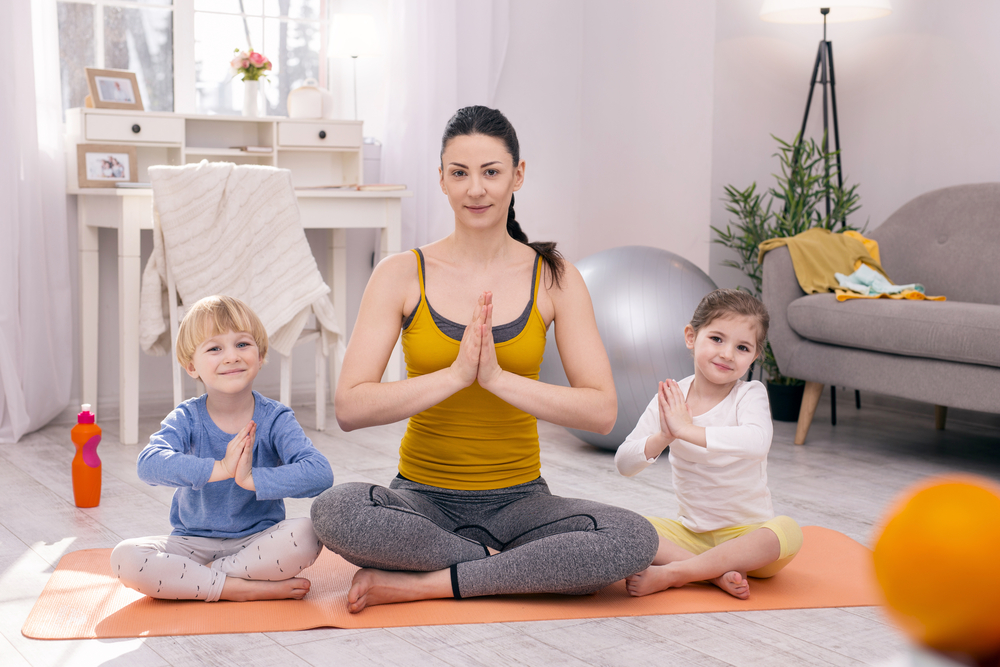
By incorporating meditation for kids into your child’s daily routine, you’re helping them learn to use it as a tool to combat stress and refocus whenever they need to!
With consistency and practice, your child will be looking forward to their daily meditation in no time.
Combine your child’s meditation practice with the HOMER Learn and Grow app to watch them build essential skills for school and life! In addition to reading, math, and thinking skills, this app can help facilitate their social and emotional learning, providing opportunities for your child to identify emotions.
,


